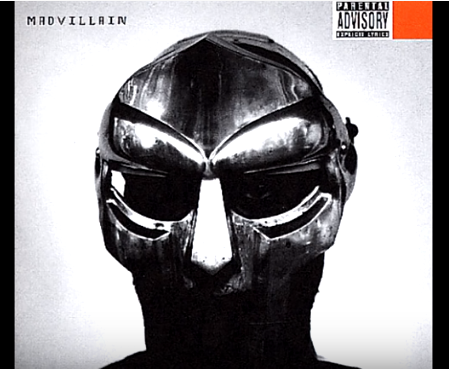Fifteen years ago, one of the most legendary albums in the history of underground Hip-Hop was introduced to the world.
Released on March, 23, 2004, “Madvillainy” is the sole album by Madvillain, a duo consisting of two of underground Hip-Hop’s most revered rappers and producers, MF DOOM and Madlib, respectively.
MF DOOM (real name Daniel Dumile) is often regarded as “Your favorite rapper’s favorite rapper.” And it shows. Numerous rappers, be they low-key or high-profile, underground or mainstream, have praised DOOM. Whether it’s in the case of Mos Def going on a seven-minute fanboy rant or the monotone, offbeat rhyme schemes and double entendres of Earl Sweatshirt, DOOM’s influence is littered throughout the rap world.
Madvillain’s other half, the producer known as Madlib (real name Otis Jackson Jr.), is one of Hip-Hop’s most creative electronic maestros. Recently, his most notable work consists of producing the 2019 album “Bandana” with rapper Freddie Gibbs and being the brains behind the beat of the Kanye West single “No More Parties in L.A.,” which appears on West’s 2016 album “The Life of Pablo.” Jackson composed the beat using just an iPad.
The result of several months and countless hours of two creative geniuses joining forces for what remains their only collaborative effort, “Madvillainy” is an exercise in wordplay, obscure samples and cheeky humor.
My first encounter with the album was in some ways by pure chance. It was in December of 2017, around the second week. I had just finished my final exam for the semester and was on one of the computers in the library, relaxing after a long, stressful four months of quizzes and assignments. I had heard of MF DOOM a few years prior, having listened to the song “Doomsday” out of curiosity and being relatively unimpressed.
However, for whatever reason, as I sat at the computer terminal aimlessly browsing YouTube while the sound of the Starbucks coffee grinder pierced throughout the mostly empty library, I suddenly got the urge to give DOOM’s music another chance. And I’m so glad that I did.
I decided that I would type his name in the search query and click on whichever song I thought had the most interesting title. Less than fifteen seconds later, I came across the track “Accordion” and was sent into a trance-like state.
I remember it like it was yesterday. As soon as I clicked the video, I couldn’t believe what I was hearing. The sound of an accordion and what seemed to be a ticking noise in the background (“A clock?” I pondered to myself). On paper, these two sounds should be like nails on a chalkboard. Yet, thanks to Madlib’s production, they give the song a somber, introspective feel to accompany DOOM’s monotone yet effortlessly smooth rhyme patterns.
I played the song over and over again, my head resting in my palm and eyes darting around while my mind tried to process the music coming from my earbuds. Before I knew it, three hours had flown by, so I quickly downloaded the track onto my phone and left campus. The song served as the soundtrack for my commute back home. With cold air and snow flurries swirling around my head, “Accordion” made everything else fade into the background.
The following day, I returned to Sinclair’s library and decided to listen to “Madvillainy,” the album that “Accordion” is featured on. As soon as the first track (“The Illest Villains”) began, I knew that I was in for something completely unique. At just under two minutes, the intro track is jam-packed with countless samples from what sounds like old movies, TV shows and cartoons, an implication of what listeners should prepare themselves for.
The intro weaves seamlessly into track two, the aforementioned “Accordion.” In addition to being a standout track on an album filled with a dizzying array of memorable samples and verses, the song’s beat appears to be a favorite in the underground music scene. Madlib sampled the beat from “Experience,” a song created by fellow producer and California native Daedelus.
Continuing with this fashion, both “Experience” and “Accordion” were eventually blended together into one cohesive track by Flying Lotus, yet another producer and California native of underground fame. If you’ve ever watched Adult Swim, there’s no doubt that you’ve heard snippets of his music played during the programming block’s signature “bumps.”
And if that wasn’t enough, way before he became the world-famous star that he is now, even Drake—yes, that Drake—paid homage with his own rendition of “Accordion” in a track titled “The Grind.”
From beginning to end, “Madvillainy” is a work of art—a sonic masterpiece of Jean-Michel Basquiat proportions crafted by a match made in studio heaven.
With its iconic King Crimson/Madonna-inspired album cover, “Madvillainy” debuted with critical acclaim and shook up the underground during the early aughts while 50 Cent and G-Unit ruled the mainstream.
Whether it’s the tongue-twisting rhyme schemes of “Meat Grinder,” the appearance of Quasimoto—Madlib’s chipmunk-voiced alter-ego—on the trippy “Shadows of Tomorrow,” or “Eye,” a gentle R&B track performed by singer Stacy Epps, “Madvillainy” reigns as a cult classic.
If you have an eclectic ear for music, this is one album that you don’t want to miss out on.
Standout Tracks: “Accordion,” “Meat Grinder,” “Shadows of Tomorrow,” “Money Folder,” “All Caps”
Rating: 10/10
Quinton Bradley
Contributing Writer
Quinton Bradley is an Ohio-based writer. He runs a blog called Hammers and Papyrus and can be followed on Twitter @QBAbstract.

